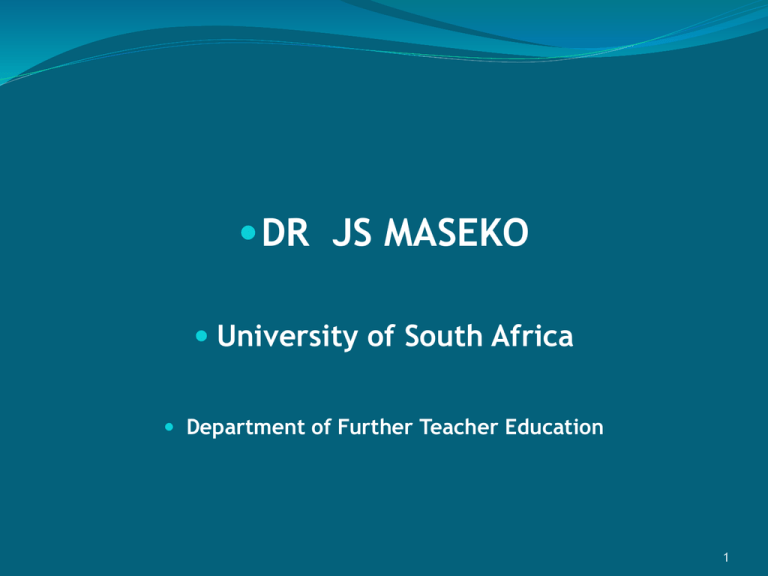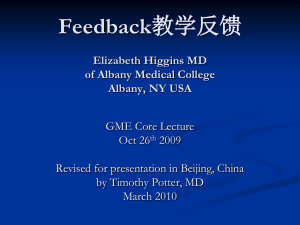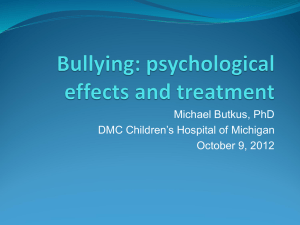Prevention of bullying in South African public secondary
advertisement

DR JS MASEKO University of South Africa Department of Further Teacher Education 1 Abstract This study examines whether treating or punishment is a deterrence to bullying behavior in public secondary schools. An increasing learners’ violence behavior, bullying can be observed and is fueled through recent incidents in a school were a group of boys raped a girl in front of other classmates and it received intense media coverage. The police arrested the boys and within 12 hours the boys were released to the parents custody and psychological and medical approaches will applied as treatment to their diseases. The study investigates whether application of treatment action theory is a deterrence to learner violent behavior, or bullying in schools? The question is: what answers the education system / justice system has for learners who violate the law and exhibit anti –social behavior? The project is qualitative followed by semi structured interviews containing open questions which the interviewee could answer in his/her own way (May 2001:123). Interviewee were 2 Prevention of bullying in South African Public secondary schools through treatment or punishment 3 The study explore ways of reducing learner delinquency in schools 4 Research question How does the South African justice system /school system addresses learner delinquent behaviour? What sanctions are imposed upon learner delinquency? 5 Theoretical paradigm ABSOLUTE THEORY OF RETRIBUTION -Seeks to repay for damage / or harm inflicted by the offence PUNISHMENT AS CRIME PREVENTION -Serves the avoidance of potential offenders. (Mortimer, 2002:10) Scaring potential offenders straight, or through re-socialisation of delinquent 6 DEFINITION OF TERMS Teenage delinquency refers to children who have the age of criminal responsibility. Juvenile delinquency / Youth delinquency Bullying is to enforce one person’s (or group) power over another person can occur in any context in which human beings interact ( Fuller 2006) e.g. School, family, the work place, nations 7 DEFINITION Doli incapax – incapable from telling the right from the truth ( was abolished in 1998) 8 DEFINITION Doli incapax - Incapable from telling the right from the truth 9 METHODOLOGY Qualitative approach Target group – Grade 8 learners Low SES secondary public schools Principals, educators, social worker, a police Officer, SGB = 8 interviewees Semi structured interview Open ended question ( May 2001:123) 10 FINDINGS Learner violent anti social behaviour has increased. Bullies target pro social learners Bullies target learner who are high achievers 11 FINDINGS Professional role ambiguity I teach Grade 8 with 45 learners. LF reported LM showed me a message from her mobile telephone with serious threats. I ask LM about and threatened LF in my present. I refer the matter to the principal. In the present of the principal LM gave LM a clap and stabbed LF on the shoulder. Police were called and LM gave LF another clap in the police station. We left LM in the police station and within two hours LM entered the school with the police referring the LM to the custody of the parents. I thought about the incident and I realized that I am also not safe in the classroom (Educator A). 12 FINDINGS Treatment is a deterrent to violent bullies. Is treatment of teenage criminality by psychologists Is treatment of criminality by medical examination effective? Punishment is a deterrent to violent bullies 13 CONCLUSION School culture vs parental culture : - The conclusion gave a perception of teenage crime in low SES as prevalent and a threat to public .secondary education - The distinct ways of legislation and policy implementation and their transfer into practice has proof to be complicated. - Research in the field might also complete and / or challenge here the findings and deepen the experience made by law makers in education as well as in the justice system 14 15











